
The County Hall is a municipal building complex in Pegs Lane, Hertford, Hertfordshire. The building, which is the headquarters of Hertfordshire County Council, is a Grade II* listed building.

Colchester Town Hall is a municipal building in the High Street in Colchester, Essex, England. The town hall, which is the headquarters of Colchester Borough Council, is a Grade I listed building.

Great Yarmouth Town Hall is a municipal building in Hall Plain, Great Yarmouth, Norfolk, England. The town hall, which is the meeting place of Great Yarmouth Borough Council, is a Grade II* listed building.
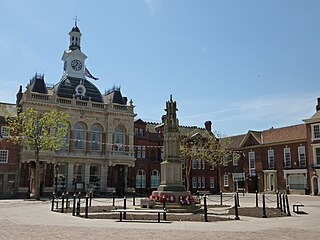
Retford Town Hall is a municipal building in The Square, Retford, Nottinghamshire, England. The town hall, which was the meeting place of Retford Borough Council, is a grade II listed building.

Bridgwater Town Hall is a municipal building in the High Street, Bridgwater, Somerset, England. The town hall, which was the headquarters of Bridgwater Borough Council, is a Grade II listed building.

Huntingdon Town Hall is a municipal structure on Market Hill in Huntingdon, Cambridgeshire, England. The town hall, which was the headquarters of Huntingdon Borough Council, is a Grade II* listed building.

Newport Guildhall is a municipal structure in the High Street in Newport, Isle of Wight, England. The guildhall, which was the headquarters of Newport Borough Council, is a Grade II* listed building.
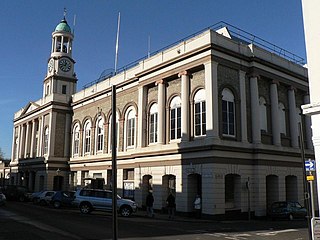
Ryde Town Hall is a municipal structure in Lind Street in Ryde, Isle of Wight, England. The town hall, which was the headquarters of Ryde Borough Council, is a Grade II listed building.
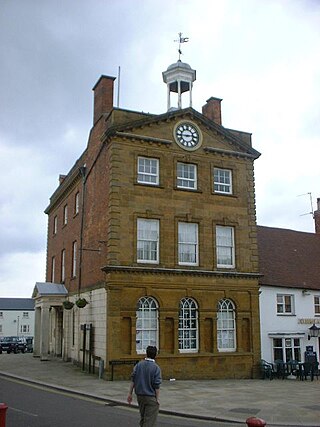
The Moot Hall is a municipal building in Chapel Lane in Daventry, Northamptonshire, England. The building, which was the headquarters of Daventry Borough Council, is a Grade II* listed building.

Godalming Borough Hall is a municipal building in Bridge Street in Godalming, England. The building is the meeting place of Godalming Town Council.
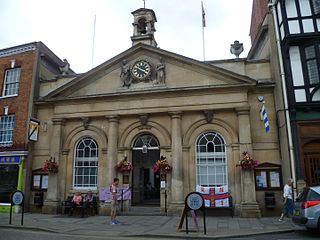
Tewkesbury Town Hall is a municipal building in the High Street in Tewkesbury, Gloucestershire, England. The building, which is the meeting place of Tewkesbury Town Council, is a Grade II* listed building.

Tiverton Town Hall is a municipal building in St Andrew Street in Tiverton, Devon, England. The structure, which was the meeting place of Tiverton Borough Council, is a Grade II listed building.
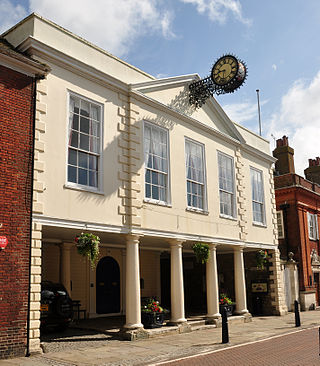
Hythe Town Hall is a municipal building in the High Street, Hythe, Kent, England. The structure, which is the meeting place of Hythe Town Council, is a Grade II* listed building.

Glastonbury Town Hall is a municipal building in Magdalene Street, Glastonbury, Somerset, England. The structure, which is the meeting place of Glastonbury Town Council, is a Grade II* listed building.

Great Torrington Town Hall is a municipal building in the High Street, Great Torrington, Devon, England. The town hall, which is the meeting place of Great Torrington Town Council, is a Grade II listed building.

Poole Guildhall is a municipal building in Market Street, Poole, Dorset, England. The guildhall, which is used as a register office and a venue for weddings and civil partnership ceremonies, is a Grade II* listed building.

Witham Town Hall is a municipal building in Newland Street, Witham, Essex, England. The building, which is the meeting place of Witham Town Council, is a Grade II listed building.

Chipping Norton Town Hall is a municipal building in the Market Place, Chipping Norton, Oxfordshire, England. The building, which is used as an events venue, is a Grade II* listed building.

Garstang Town Hall is a municipal building in the High Street in Garstang, Lancashire, England. The structure, which currently accommodates two shops and a Royal British Legion Club, is a Grade II listed building.

The Moot Hall is a municipal building in Boroughgate, Appleby-in-Westmorland, Cumbria, England. The building, which is currently used as the meeting place of Appleby-in-Westmorland Town Council, is a Grade II* listed building.





















